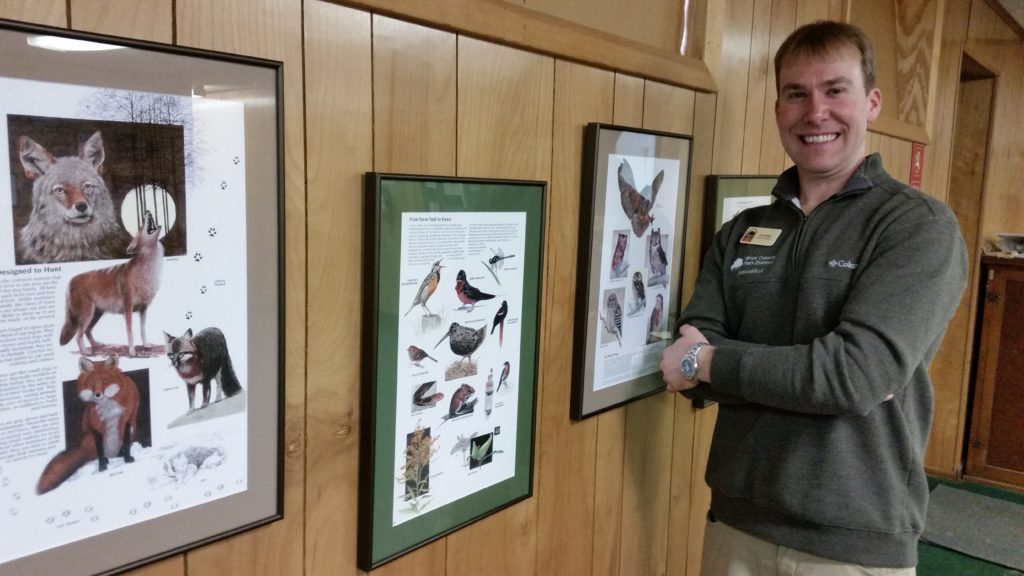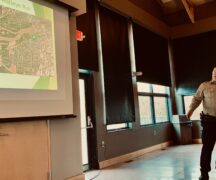By JAN LARSON McLAUGHLIN
BG Independent News
Armed with all kinds of apps and maps, people from around the world come to this area every spring and raise their binoculars to catch glimpses of migrating birds. Experienced birders and novices alike marvel that birds – some weighing less than an empty pop can – travel up to 1,800 miles to or through this region each year.
Bird migrations have always fascinated Wood County Park District Program Coordinator Jim Witter, who shared some of his birding knowledge this past week during a virtual meeting of the Bowling Green Kiwanis Club.
Witter became hooked on wildlife in second grade when he spotted his first belted kingfisher. In fifth grade, he recorded in his journal his dream to become a naturalist.
Though he has been studying wildlife for years, Witter continues to be amazed at the migratory flights of birds – some traveling from as far away as South America to reach this region in the warm months.
“This is a trip full of hazards and fraught with peril,” he said. “Why do they undertake this long trip? Why not just stay down – like many birds – in the tropics?”
Their goals for making the journey are food, resources, and breeding.
Some birds, including warblers, migrate during the night using stars for navigation. Others, like blue jays and hawks, travel during the day using landmarks like shorelines, mountains or lakes to lead them to their destinations.
“They don’t need to ask for directions,” he said. “It’s genetically imprinted on their little bird brains.”

Some travel great distances, like warblers from Central and South America, and others have shorter routes like blue jays and great egrets. Some fly in flocks, others are loners.
Birds, Witter said, are able to take mini naps that he compared to being on screensaver mode during the day. Some are even able to rest half of their brains by closing one of their eyes. Closing both could prove very risky, he said.
Some of the long haulers are only at their northern destinations for a few weeks before they have to head back south.
Their trips in the spring are often more in haste since the birds must establish their territory and breeding grounds. They have limited time to gather food and find a good location to attract female friends.
The Lake Erie region in early May is a hotspot for bird migration – and therefore, birdwatching.
“Our part of the country is literally one of the best places in the world to see spring migrations,” Witter said. The only rival to this region is the Texas gulf coastline, he added.
Among the favorite migrants to this area are 35 types of warblers. “We’re a magnet for warblers,” he said.
Like their winged counterparts, birdwatchers also make the annual trek here.
“People literally take off work and come here to watch birds,” Witter said. “They travel long distances, from around the world.”
This region offers a diversity of habitat, including wooded areas along creeks, the Maumee River, Lake Erie, plus great parks like Oak Openings and those in Wood County and Bowling Green, Witter said.
“We have a lot of great wild places,” he said. “If you’re a birder, it’s a pretty great place to live in Wood County.”
Some of the migrating birds take a breather, or divert their routes when they hit Lake Erie, Witter said.
“They tend to be a little leary of crossing a big body of water,” he said.
Though this area is still rich with migrating birds each spring, Witter said bird conservation experts have kept track of declines in many species. The primary reason for the decrease in birds is the loss of habitats, he added.
Other contributing factors are light pollution, which causes distraction and disorientation for nocturnal migrants especially through urban areas.
Climate change has also created problems since the timing of migratory trips must coincide with certain plants coming out in the spring. If those plants blossom early, the insects which eat them come early – which could cause the birds to miss the window of time to feed on the insects, Witter explained.
“If there’s a mismatch in the timing, there is less food,” he said.
Witter offered some suggestions on how humans can reduce the odds against migratory birds:
- Plant native plants. Those will attract insects that the birds can feast on.
- Turn off outdoor lights during migratory seasons.
- Limit pesticide use.
- Keep cats inside.
And look upward this spring. Binoculars and birding apps are not necessary to marvel at the small travelers who come from far to visit this region every year.





